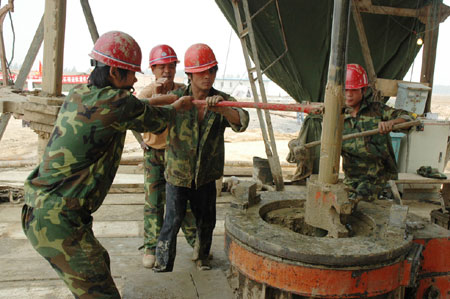Pictures
Sinopec to boost unconventional gas production capacity by 2015
By Wan Zhihong (China Daily)
Updated: 2010-06-02 10:25
 |
Large Medium Small |
|
 |
|
Workers drill for gas at a Sinopec base in Huaibei, Anhui province. The company is in talks with Britain's BP Plc over potentially collaborating in the exploration and development of shale gas in China. Liu Wuxiu / for China Daily |
Sinopec Group (Sinopec), the country's second-largest oil company, plans to increase its unconventional gas production capacity to more than 2.5 billion cubic meters annually by the end of 2015, a move in line with China's efforts to diversify its energy mix.
Sinopec will speed up the development of unconventional gas including shale gas and coalbed methane during the central government's 12th Five-Year Plan period (2011-15).
Development of unconventional oil and gas will become an important growth engine for the company's business in the next five to 10 years, the company said in a statement on its website Tuesday.
The company has started unconventional oil and gas exploration and development in Shanxi, Shaanxi, Guizhou, Anhui and Jiangsu provinces, said the statement.
According to Sinopec's 2009 corporate social responsibility report, the company has set plans to develop coalbed methane mainly in northern China, and shale gas in southern part of the country.
"Sinopec has been paying increasing attention to the development of new energies. We have now extended the business into many areas including unconventional gas and geothermal energy," said Huang Wensheng, spokesman for Sinopec.
The company is in talks with Britain's BP Plc over potentially collaborating in the exploration and development of shale gas in China. Analysts said using more advanced foreign technology in the sector would accelerate the exploitation of China's gas reserves.
China's largest oil company, China National Petroleum Corp (CNPC) in March signed an agreement with Royal Dutch Shell Plc to jointly develop and produce tight gas in China's Sichuan Basin. Tight gas is natural gas contained in rock that must be fractured or broken open before it can flow easily to production wells.
The companies have submitted a production-sharing contract to the Chinese government for approval. Under the 30-year contract, CNPC and Shell will appraise and develop tight gas reservoirs in an approximately 4,000 square kilometer area in the Jinqiu block of central Sichuan province.
CNPC is accelerating the development of new energies including coalbed methane, fuel ethanol and oil sands, aiming to set its annual oil-equivalent production capacity at 1.25 million tons this year.
The company will further increase capacity to 6 million tons of oil equivalent in 2015, according to Zhou Mingchun, chief financial officer of PetroChina.
Unconventional gas may account for 30 percent of China's total gas output by 2020, said Jie Mingxun, president of the coalbed methane unit under PetroChina, the listed arm of CNPC.
Use of unconventional gas would be an effective substitute to meet China's rising natural gas demand, said analysts.
The nation's annual demand for the clean energy will grow to 300 billion cubic meters by 2020, according to the researcher.
Between 2000 and 2008, China's annual consumption of natural gas increased 16.2 percent on average, 9.7 percentage points higher than the annual growth rate for oil consumption, or 6.6 percentage points higher than the annual growth rate for coal consumption.



